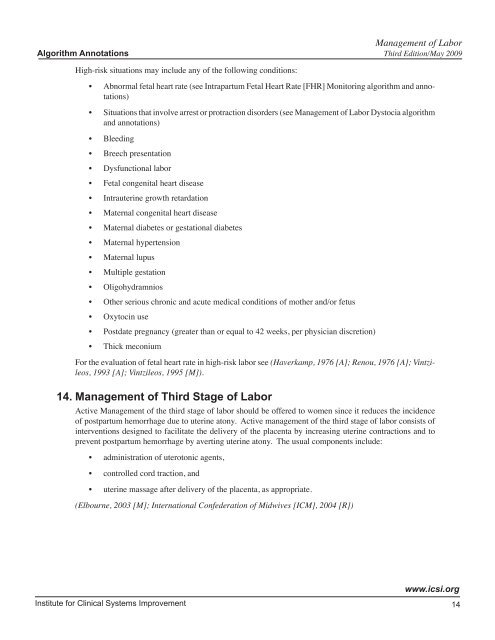Management of Labor
Management of Labor
Management of Labor
You also want an ePaper? Increase the reach of your titles
YUMPU automatically turns print PDFs into web optimized ePapers that Google loves.
<strong>Management</strong> <strong>of</strong> <strong>Labor</strong><br />
Algorithm Annotations Third Edition/May 2009<br />
High-risk situations may include any <strong>of</strong> the following conditions:<br />
• Abnormal fetal heart rate (see Intrapartum Fetal Heart Rate [FHR] Monitoring algorithm and annotations)<br />
• Situations that involve arrest or protraction disorders (see <strong>Management</strong> <strong>of</strong> <strong>Labor</strong> Dystocia algorithm<br />
and annotations)<br />
• Bleeding<br />
• Breech presentation<br />
• Dysfunctional labor<br />
• Fetal congenital heart disease<br />
• Intrauterine growth retardation<br />
• Maternal congenital heart disease<br />
• Maternal diabetes or gestational diabetes<br />
• Maternal hypertension<br />
• Maternal lupus<br />
• Multiple gestation<br />
• Oligohydramnios<br />
• Other serious chronic and acute medical conditions <strong>of</strong> mother and/or fetus<br />
• Oxytocin use<br />
• Postdate pregnancy (greater than or equal to 42 weeks, per physician discretion)<br />
• Thick meconium<br />
For the evaluation <strong>of</strong> fetal heart rate in high-risk labor see (Haverkamp, 1976 [A]; Renou, 1976 [A]; Vintzileos,<br />
1993 [A]; Vintzileos, 1995 [M]).<br />
14. <strong>Management</strong> <strong>of</strong> Third Stage <strong>of</strong> <strong>Labor</strong><br />
Active <strong>Management</strong> <strong>of</strong> the third stage <strong>of</strong> labor should be <strong>of</strong>fered to women since it reduces the incidence<br />
<strong>of</strong> postpartum hemorrhage due to uterine atony. Active management <strong>of</strong> the third stage <strong>of</strong> labor consists <strong>of</strong><br />
interventions designed to facilitate the delivery <strong>of</strong> the placenta by increasing uterine contractions and to<br />
prevent postpartum hemorrhage by averting uterine atony. The usual components include:<br />
• administration <strong>of</strong> uterotonic agents,<br />
• controlled cord traction, and<br />
• uterine massage after delivery <strong>of</strong> the placenta, as appropriate.<br />
(Elbourne, 2003 [M]; International Confederation <strong>of</strong> Midwives [ICM], 2004 [R])<br />
Institute for Clinical Systems Improvement<br />
www.icsi.org<br />
14
















